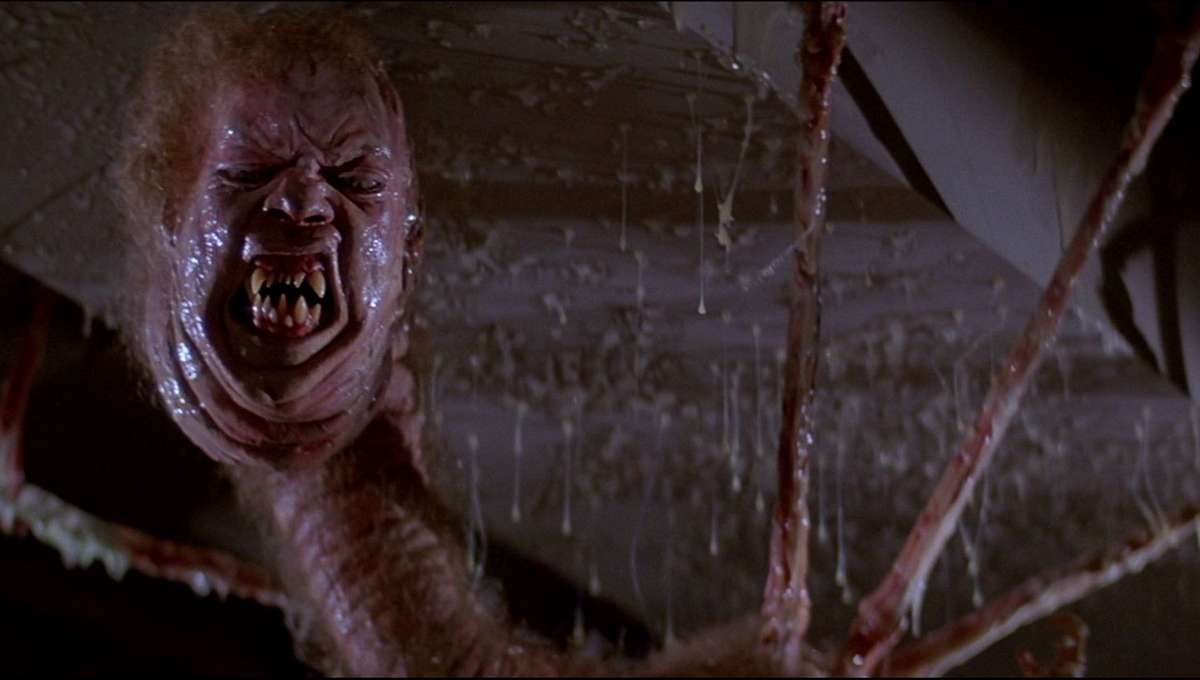The Thing (1982)

John Carpenter’s 1982 film *The Thing* is a seminal work in the science fiction and horror genres, renowned for its groundbreaking special effects, intense atmosphere, and exploration of paranoia and isolation. Though initially met with mixed reviews and modest box office success, the film has since garnered significant acclaim, establishing itself as a classic and profoundly influential piece of cinema. *The Thing* not only stands as a testament to Carpenter’s directorial prowess but also as a significant contribution to the genre of body horror.
Set in the desolate and frozen landscape of Antarctica, *The Thing* follows a group of American scientists stationed at a remote research facility. The film begins with the arrival of a Norwegian helicopter that is in pursuit of a dog, which is subsequently brought to the base. The dog, however, is not what it seems. It is later revealed to be an extraterrestrial life form capable of assimilating and imitating other organisms.

As the alien organism begins to attack and replicate members of the crew, the scientists face not only the terrifying threat of the creature but also the growing mistrust and paranoia among themselves. The film delves into the psychological and physical horrors of this scenario, as the characters struggle to determine who is still human and who has been taken over by the alien entity. The situation escalates to a climax of fear and desperation as the crew’s trust erodes and the alien’s true nature is revealed.
Carpenter’s direction in *The Thing* is marked by a deliberate, suspenseful pacing that keeps the audience on edge. The film’s tension is masterfully built through a combination of claustrophobic settings, eerie sound design, and visual effects that shock and unsettle. Carpenter’s use of practical effects, particularly the innovative and grotesque creature designs by special effects artist Rob Bottin, plays a pivotal role in the film’s impact. These effects, while groundbreaking for their time, contribute to the visceral and horrifying nature of the alien transformations.
The film’s visual style is defined by its stark, cold environments, which enhance the sense of isolation and vulnerability. The snowy, isolated setting of the Antarctic base creates a backdrop that amplifies the characters’ sense of entrapment. Carpenter’s use of lighting—often dim and harshly contrasting—further heightens the atmosphere of dread and uncertainty.

*The Thing* is a deep exploration of themes such as paranoia, identity, and survival. The film delves into the psychological horror of not knowing who can be trusted and the fear of losing one’s identity. The concept of assimilation and the inability to distinguish friend from foe serve as metaphors for broader fears about trust and the unknown.
The isolation of the Antarctic setting adds another layer to the film’s themes. The crew’s physical isolation mirrors their emotional and psychological isolation as they are cut off from the outside world, intensifying their sense of helplessness. The harsh environment and constant threat of the alien creature force the characters to confront their most primal fears and instincts.
Upon its release, *The Thing* faced criticism for its graphic content and bleak tone, which overshadowed its critical acclaim. However, as time has passed, the film has been reevaluated and is now recognized as a groundbreaking work of horror and science fiction. It has gained a dedicated following and is celebrated for its technical achievements, particularly in the realm of practical effects, which have influenced countless films and filmmakers.
The film’s legacy is also evident in its impact on the horror genre. Its innovative approach to body horror and its exploration of paranoia and distrust have inspired numerous works in the genre, contributing to its enduring relevance. The film’s influence can be seen in its impact on subsequent horror films and its continued presence in popular culture.
John Carpenter’s *The Thing* stands as a masterful blend of horror and science fiction, characterized by its intense atmosphere, innovative special effects, and exploration of deep-seated fears. Through its portrayal of isolation, paranoia, and the terrifying unknown, the film challenges viewers to confront their own anxieties and uncertainties. Its legacy as a genre-defining classic is a testament to Carpenter’s skillful direction and the film’s profound impact on the landscape of horror cinema. *The Thing* remains a chilling and thought-provoking experience, solidifying its place as a timeless and influential work in the world of film.










